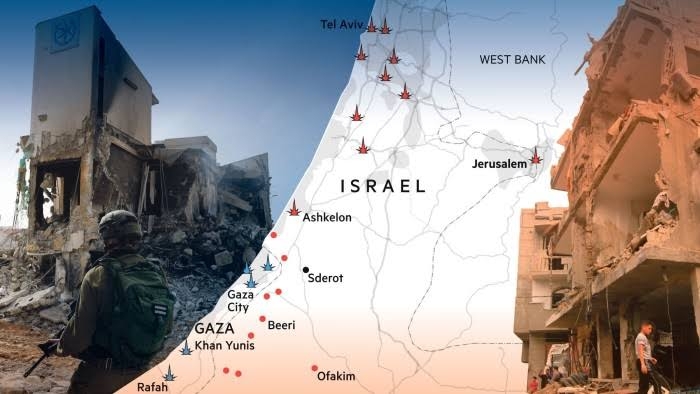Israel–Hamas war
In a single day, over 1,200 Israelis, primarily civilians, including women and children, were killed in a row in several towns, about 3000 civilians were heavily wounded and at a music festival near the Kibbutz of Re"im, where over 270 party-goers were murdered.

A series of coordinated attacks were convoyed by the Palestinian Islamist terrorist group Hamas, from the Gaza Strip onto bordering areas in Israel, commenced on Saturday 7 October 2023, a Sabbath day and date of several Jewish holidays. The attacks, referred to as Operation Al-Aqsa Flood by Hamas and a Black Saturday in Israel, initiated the ‘2023 Israel–Hamas war’.
The gruesome attack began in the early morning with a rocket barrage of at least 3,000 rockets against Israel and vehicle-transported incursions into its territory. Palestinian-Hamas terrorists breached the Gaza–Israel barrier, killing civilians in neighboring Israeli communities and attacking military bases.
In a single day, over 1,200 Israelis, primarily civilians, including women and children, were killed in a row in several towns, about 3000 civilians were heavily wounded and at a music festival near the Kibbutz of Re'im, where over 270 party-goers were murdered. Around 200 Israeli civilians and soldiers were taken as hostages to the Gaza Strip of which there were school- going children, also kidnapped.
The day can be remarked as the bloodiest in Israel’s history and the deadliest for Jews since the Holocaust. This gruesome event, was described by Washington Post as being on par with the worst atrocities that al-Qaeda, al-Qaeda in Iraq or the Islamic State ever perpetrated.
What is Gaza Strip & who lives there ?
The Gaza Strip is a 41km (25-mile) long and 10km-wide territory located between Israel, Egypt and the Mediterranean Sea.
Originally occupied by Egypt, Gaza was captured by Israel during the 1967 Six Day war.
Israel withdrew its troops and around 7,000 settlers from the territory in 2005.It is home to 2.23 million people and has one of the highest population densities in the world.
Just over 75% of Gaza’s population – some 1.7 million people – are registered refugees or descendants of refugees, according to the UN. More than 500,000 of them live in eight crowded camps located across the Strip.
Israel controls the air space over Gaza and its shoreline, and has strictly controlled the movement of people and goods.
What is Palestine?
The West Bank and Gaza, which are known as the Palestinian territories, as well as East Jerusalem and Israel all formed part of a land known as Palestine from Roman times until the mid-20th Century.
These were also the lands of Jewish kingdoms in the Bible, and are seen by many Jews as their ancient homeland.
Israel was declared a state in 1948, though the land is still referred to as Palestine by those who do not recognise Israel’s right to exist.
Palestinians also use the name Palestine as an umbrella term for the West Bank, Gaza and East Jerusalem.
The Palestinian president is Mahmoud Abbas, also known as Abu Mazen. He is based in the West Bank, which is under Israeli occupation.
He has been the leader of the Palestinian Authority (PA) since 2005, and represents the Fatah political party, a bitter rival of terrorist group Hamas.
What is Hamas ?
HAMAS formed in late 1987 at the beginning of the first Palestinian intifada (uprising). Its roots are in the Palestinian branch of the Muslim Brotherhood, and it is supported by a robust sociopolitical structure inside the Palestinian territories.
The group’s charter calls for establishing an Islamic state in place of Israel and rejects all agreements made between the PLO and Israel. HAMAS’ strength is concentrated in the Gaza Strip and areas of the West Bank.
HAMAS has a military wing known as the Izz al-Din al-Qassam Brigades that has conducted many anti-Israel attacks in both Israel and the Palestinian territories since the 1990s.
These attacks have included large-scale bombings against Israeli civilian targets, small-arms attacks, improvised roadside explosives, and rocket attacks.
The group in early 2006 won legislative elections in the Palestinian territories, ending the secular Fatah party’s hold on the Palestinian Authority and challenging Fatah’s leadership of the Palestinian nationalist movement.
HAMAS continues to refuse to recognize or renounce violent resistance against Israel and in early 2008 conducted a suicide bombing, as well as numerous rocket and mortar attacks that have injured civilians.
The US Government has designated HAMAS a Foreign Terrorist Organization.
History of Israel Palestine conflict
The history of the Israeli–Palestinian conflict traces back to the late 19th century when Zionists sought to establish a homeland for the Jewish people in Ottoman-controlled Palestine.
The Balfour Declaration of 1917, issued by the British government, endorsed the idea of a Jewish homeland in Palestine, which led to an influx of Jewish immigrants to the region. Following World War II and the Holocaust, international pressure mounted for the establishment of a Jewish state in Palestine, leading to the creation of Israel in 1948.
The establishment of Israel, and the war that followed and preceded it, led to the displacement of hundreds of thousands of Palestinians who became refugees, sparking a decades-long conflict between Israel and the Palestinian people.
The Palestinians seek to establish their own independent state in at least a part of historic Palestine. Israeli defense of its own borders, control over the West Bank, the Egyptian-Israeli blockade of the Gaza Strip, and Palestinian internal politics currently make this goal out of reach.
Numerous peace negotiations have taken place over the years, but a lasting peace agreement has remained elusive. The conflict has been marked by violence, including terrorist attacks by Palestinian militants and military operations by Israel.
The United States and other countries have played a key role in attempting to broker peace, but many obstacles remain, including the issue of Israeli settlements in the West Bank, the status of Jerusalem, and the ultimate fate of Palestinian refugees.

Kewali Kabir is a sophomore and a social environmental prospector,


